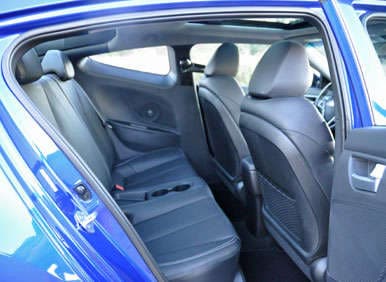Recent Articles
Popular Makes
Body Types
2013 Hyundai Veloster Turbo Road Test and Review
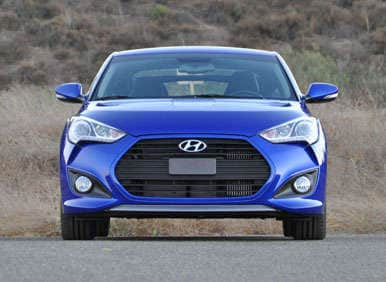
Defying clear classification, the Hyundai Veloster is part econo-hatch, part sport coupe, part shooting brake, and 100% funky. It shares a wheelbase with the new Elantra GT hatchback, an engine with the entry-level Accent, and is equipped with an extra door on the right side of the car to allow easier access to the two-passenger rear seat. The Veloster’s styling is, and I’m putting this mildly, unconventional. But that’s the secret of its charm.
For 2013, the front-wheel-drive Veloster is offered with a new turbocharged four-cylinder engine, which lends credibility to a model name inferring velocity. The Veloster Turbo includes more than just extra horsepower and torque, though, with sport-tuned steering, bigger wheels and tires, and a number of cabin upgrades attempting to justify its double-deuce starting price.
To find out if the new Veloster Turbo lives up to its name, I spent a week with this Marathon Blue example, using the well-equipped test car for commuting, running errands, shuttling offspring, and chasing velocity on local mountain roads.
2013 Hyundai Veloster Turbo Review: Pricing and Trim Levels
The new Veloster Turbo starts at $21,950, or $3,725 more than a standard Veloster. That premium pays for the turbocharged engine with 63 extra horsepower and 72 more lb.-ft. of torque at lower rpm, recalibrated electric steering for a sportier feel, and a set of 18-inch aluminum wheels with chrome spears on the spokes. Additionally, the Veloster Turbo includes a restyled front end with fog lights and projector-beam headlights, turn signal indicators integrated into the exterior mirror housings, a body kit, and LED taillights.
There’s more to this car than hardware and cosmetic upgrades. The interior includes leather upholstery, a power driver’s seat, heated front seats, metallic pedals, electroluminescent gauges, and a 450-watt Dimension premium sound system. Hyundai’s Proximity Key keyless entry and push-button ignition system is also standard.
If you can’t operate a manual transmission, you’ll need the automatic, which runs an extra grand but includes paddle shifters and an Active Eco system designed to improve fuel economy. Special Matte Gray paint is also a thousand bucks, and a set of Michelin Pilot Super Sport summer performance tires runs $1,200 and, according to Hyundai, increases skidpad performance from 0.82g to 0.94g.
Next, consider whether you want the Ultimate Package ($2,500). It includes a panoramic sunroof, a navigation system, a reversing camera, reversing sensors, a 115-volt power outlet, and automatic headlights. An auto-dimming rearview mirror with a universal garage door opener ($250) and an interior light kit ($250) are available, and several additional extras all running less than $100 each: floor mats, a cargo mat, a cargo net, and wheel locks.
In addition to the optional reversing camera and reversing sensors, the Veloster Turbo is equipped with standard safety features including six airbags, 4-wheel-disc antilock brakes with brake assist, a traction control system, and a stability control system. Crash tests had not been performed on the Veloster as this review was published.
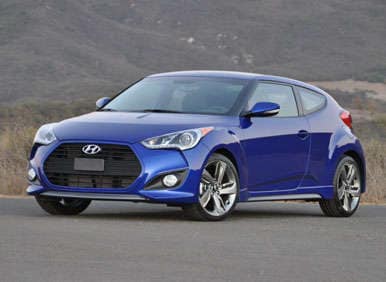
2013 Hyundai Veloster Turbo Review: What It’s Up Against
This Veloster Turbo test car included the automatic transmission, the Ultimate Package, the Michelin Super Sport tires, the auto-dimming rearview mirror, and the floor mats, for a total of $27,770.
That ain’t chump change, and this price tag pits the Hyundai against a long list of performance-tweaked vehicles, including the Ford Focus ST, Honda Civic Si, Mazdaspeed 3, MINI Cooper Clubman S, Scion FR-S, Subaru BRZ, Subaru WRX, Volkswagen Beetle Turbo, and Volkswagen GTI. A well-equipped Veloster Turbo also overlaps with the upgraded Hyundai Genesis Coupe 2.0T.
That’s some seriously tough company. If you keep your fingers out of the candy jar, however, and limit upgrades to what really matters – those Michelins – you can roll out the door for less than $24K.

2013 Hyundai Veloster Turbo Review: Exterior
- Revised styling
- LED taillights
- Unique aluminum wheels
- Optional Matte Gray paint
Hyundai gives the Veloster Turbo a unique front styling treatment, one that is far more successful than, say, the design slapped onto the front of a Sonata Hybrid (shudder). In fact, this approach has the opposite effect on the Veloster, appropriate given the Turbo model’s mission to light up left-brain rather than right-brain receptors.
Trendy LED running lights and taillights are standard on the Veloster Turbo, along with a set of 18-inch alloy wheels with chrome trim on the spokes. The Turbo model is also equipped with a tasteful body kit that looks integrated with the overall styling rather than tacked on as an afterthought, but that’s probably because the Veloster wears fender swells that could make Sofia Vergara envious.
All Velosters feature a custom chopped-roof appearance, one that culminates in a short vertical rear window capped, on the Turbo models, with a roof spoiler. Blacked-out roof pillars give the impression that the roof is floating above the car’s body, and the optional panoramic sunroof combines with the rear hatch glass to make the entire top of the car appear to be one gigantic window to the world.
Unlike every other car on the market, the Veloster features a single forward-hinged access door on the right side of the car, allowing for easy access to the surprisingly roomy back seat. This feature also makes it possible to use the Veloster as a family car, though I sure would like to have another door like this one on the driver’s side.
Even the Veloster’s hood is unusual, sweeping up from the grille and headlights in a featureless arc to create a subtle ridge just forward of two fake air vents. Around back, scallops extend from the bulging taillights, drawing the eye to the center-mounted dual exhaust outlets.
Love it or hate it, there’s no question that design is a big part of the Veloster’s appeal. And I love it.
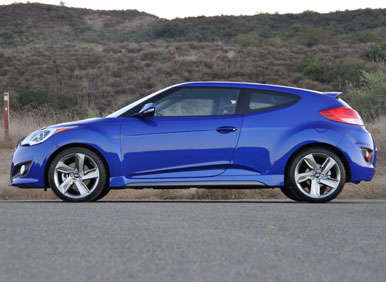
2013 Hyundai Veloster Turbo Review: Interior
- Electroluminescent gauges
- Leather seats, heated in front
- Power driver’s seat
- Available Blue interior accents
Compared to the exterior styling, the Veloster Turbo’s interior is fairly conventional. Everything is hard plastic, except for the center armrest, the door armrests and, inexplicably, the door panel inserts where you’ll never touch the car. That hard plastic tends to creak and buzz, an issue likely to worsen with mileage and time.
The Veloster’s controls are easy to master, and the color center touchscreen proves resistant to glare and responsive to commands. The Dimension premium sound system puts out plenty of power to please this car’s target buyer.
The front doors feature big basket-handle pulls wrapped in silver plastic, and if the driver sits tall in the saddle, like I do, this design element is mighty unkind to knees in hard right-hand corners. The driver’s seat offers a manual height adjuster and the steering wheel provides tilt/telescopic adjustment, so it’s easy to find a comfortable position.
The front passenger’s seat is comfortable, too, sitting high enough off the floor to offer a modicum of thigh support. The dashboard is scooped out in front of the front seat occupant, allowing that passenger to slide forward to create a little bit more room for people riding in the back.
The rear seat is surprisingly roomy, comparatively speaking. It sure isn’t easy for bigger and taller people to fold themselves into the car through the narrow rear portal, or to slide across the plastic center tray between the two rear seating positions, but once inside there’s enough space as long as you’re not taller than the average person. It would be nice, though, if the front seatbacks were covered in a soft material rather than hard plastic panels.
I carried a couple of kids around in the Veloster’s back seat, a four-year-old and a two-year-old, each sitting in forward-facing child safety seats. The four-year-old knows how to buckle herself in, which is the primary reason this car worked for this purpose. Still, it sure would be nice if the left side of the Veloster offered a rear access door matching the right side.
Hyundai says the Veloster’s trunk holds 15.3 cu.-ft. of cargo, and that rings true if you remove the cargo cover. The space proved too narrow for a full-size stroller, but a compact stroller fit lengthwise with no trouble. Fold the rear seats and the Veloster swallows 34.7 cu.-ft. of cargo. However, the rear liftover height is taller than most cars, making it more difficult to load and remove heavy items.
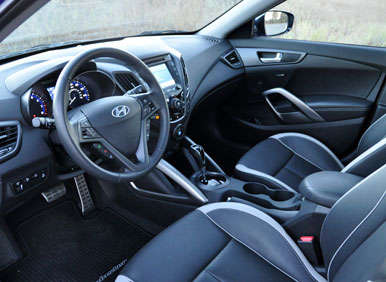
2013 Hyundai Veloster Turbo Review: Powertrain
- 201-horsepower, turbocharged engine
- Sport-tuned electric steering
- Optional summer performance tires
The Hyundai Veloster Turbo’s key ingredient is its direct-injected, turbocharged 1.6-liter four-cylinder engine, which generates 201 horsepower at 6,000 rpm and 195 lb.-ft. of torque between 1,750 and 4,500 rpm.
Compared to a standard Veloster, that amounts to 63 extra ponies at 300 fewer rpm. As great as that sounds, however, it’s the Veloster Turbo’s torque that makes all the difference in the world. The extra 72 lb.-ft. of twist is on tap from 1,750 rpm to 4,500 rpm, a broad rev range that gives the car healthy low-end thrust, more than enough to offset the Turbo model’s 216-lb. weight gain.
A six-speed manual gearbox is standard, with a six-speed automatic available as an option. The automatic includes a manual shift gate with intuitive shifting: tap up for an upshift and tap down for a downshift. Alternatively, paddle shifters are available.
My test car had the automatic transmission. According to the EPA, a Veloster Turbo so equipped is expected to get 25 mpg in the city, 34 mpg on the highway, and 29 mpg in combined driving. As is typical when I test-drive Hyundai models, my observed 23.2-mpg average didn’t put me in the same time zone as the EPA’s numbers, let alone the same vicinity. But I wasn’t using the Active Eco feature, either.
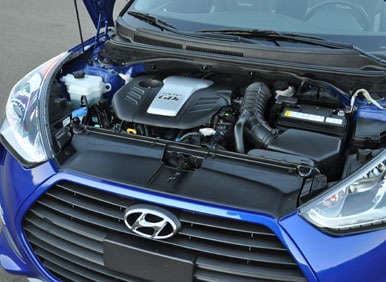
2013 Hyundai Veloster Turbo Review: How It Drives
Velocity is no problem for the 2,800-lb. Veloster Turbo, but the car doesn’t deliver quite the thrill I expected. The No Man’s Land between where the 1.6-liter engine’s peak torque drops at 4,500 rpm and peak horsepower arrives at 6,000 rpm is most likely to blame, producing a power curve different from the similarly priced, slightly more powerful and heavier 3,034-lb. Volkswagen GTI.
The GTI’s 2.0-liter makes either its peak 207 lb.-ft. or its peak 200 horsepower from 1,700 rpm all the way to 6,000 rpm, and the result is a near continuous torrent of motive force that plasters a big, fat smile on the driver’s face. The Veloster Turbo, though lighter, makes less twist across a narrower portion of the rev range, and while the car certainly is quick and capable of zipping up the side of a mountain with little effort, it just doesn’t feel as good doing it.
The Veloster Turbo’s six-speed automatic could use some work, too. Around town and on the highway, the transmission draws no undue attention to itself. It upshifts rapidly to conserve as much fuel as possible, especially with Active Eco engaged. Move the shifter into Sport mode, a position to the right of the main shift gate, and the transmission holds revs longer and downshifts sooner for more energetic response.
When shifting manually, the Veloster Turbo proved slow to respond downshift commands, and this transmission also lacks downshift rev matching, both deterrents to using the transmission’s paddle shifters or separate manual shift gate.
More so than the engine, it is the extraordinary P215/40ZR18 Michelin Pilot Super Sport tires that contribute most to the Veloster Turbo’s fun factor, for they do an outstanding job of preserving speed once it is attained. If you’re fortunate enough to live where snow is non-existent and rain is rare, I strongly recommend this $1,200 upgrade. It is so incredibly worth it.
The Veloster Turbo’s 4-wheel-disc brakes proved themselves up to the task of hard charging across the mountains. The brake pedal sits a bit high compared to the accelerator, and the driver is reminded of this upon each approach to a corner. Gratefully, Hyundai’s stability control system rarely intervenes, making the car even more fun to toss into turns.
Hyundai says the Veloster Turbo’s electric steering receives sport tuning calibration, and the modifications make this the rare Hyundai that is enjoyable to guide in the city and on the highway. Out on a favorite back road, however, it still feels disconnected from what’s happening at the contact patches, and as a result, the driver learns everything he or she needs to know from the tires and suspension.
Speaking of which, there’s no escaping the fact that the Veloster Turbo is riding on a torsion beam rear axle. Pitch the car into a high-speed sweeper, and unless the pavement is as smooth as a baby’s butt, the rear end jitterbugs as the 18-inch wheels and short tire sidewalls travel over breaks and bumps in the blacktop. Unfortunately, the steering isn’t much interested in helping to erase any feelings of instability over rougher patches of road.
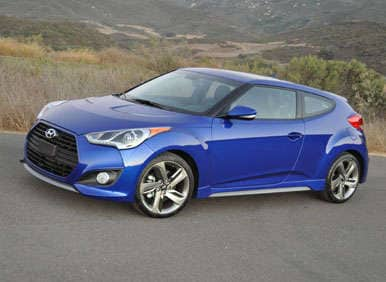
2013 Hyundai Veloster Turbo Review: Final Thoughts
At this price, Hyundai is playing in the major leagues against accomplished benchmark vehicles in the hot-hatch class. As much as I love the Veloster Turbo’s look, as comfortable as the driving position is, despite my enthusiastic appreciation for its rear access door and handy cargo space, and in spite of the Hyundai’s inherent value, I’m not ready to recommend the Veloster Turbo over most of its competitive set without additional massaging of the suspension, steering, and power curve.
I would buy this instead of a Honda Civic Si, though.
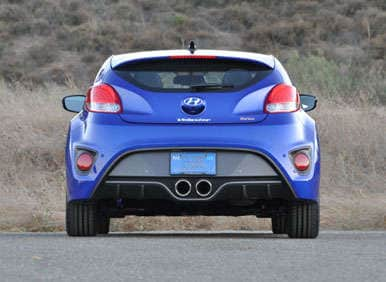
2013 Hyundai Veloster Turbo Review: Pros and Cons
- One rear-seat access door
- Distinctive design
- Hatchback utility
- Optional panoramic sunroof
- Genuine room for four adults
- Fantastic Michelin Super Sport summer tires
- Only one rear-seat access door
- Unrealistic EPA fuel economy estimates
- Gets pricey with options
- Needs downshift rev matching
- Disconnected electric steering
- Torsion beam rear axle = jittery ride and handling
Hyundai provided the vehicle for this review
2013 Hyundai Veloster Turbo Photos by Christian Wardlaw
